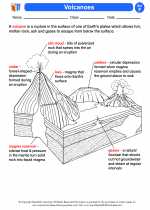Sun
The Sun is a star at the center of our solar system. It is a massive, glowing sphere of hot gases, primarily hydrogen and helium. The Sun's immense gravity holds the solar system together and provides the energy that sustains life on Earth.
Structure of the Sun
The Sun consists of several layers:
- Core: The central region where nuclear fusion occurs, converting hydrogen into helium and releasing a tremendous amount of energy.
- Radiative Zone: Energy from the core gradually moves outward through this zone in the form of radiation.
- Convective Zone: Energy is transported through this zone via the movement of hot gases.
- Photosphere: The visible surface of the Sun, where energy is emitted as light and heat.
- Chromosphere: A layer above the photosphere that is only visible during a total solar eclipse.
- Corona: The outermost layer of the Sun's atmosphere, extending millions of kilometers into space and appearing as a faint halo during an eclipse.
Solar Activity
The Sun undergoes periodic changes in activity, including sunspots, solar flares, and coronal mass ejections. These phenomena can impact space weather and cause geomagnetic storms on Earth.
Effects of the Sun
The Sun's energy drives Earth's climate and weather patterns, provides the light and warmth necessary for photosynthesis in plants, and influences the behavior of living organisms. However, excessive exposure to the Sun's ultraviolet radiation can cause sunburn and increase the risk of skin cancer.
Study Guide
.◂Science Worksheets and Study Guides Sixth Grade. Introduction to earth science

 Activity Lesson
Activity Lesson
 Worksheet/Answer key
Worksheet/Answer key
 Worksheet/Answer key
Worksheet/Answer key
 Worksheet/Answer key
Worksheet/Answer key
 Vocabulary/Answer key
Vocabulary/Answer key
 Vocabulary/Answer key
Vocabulary/Answer key
